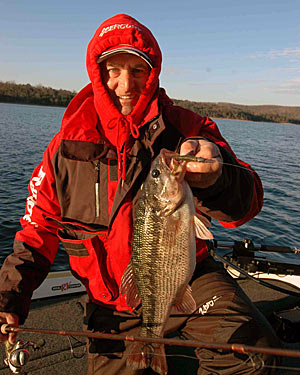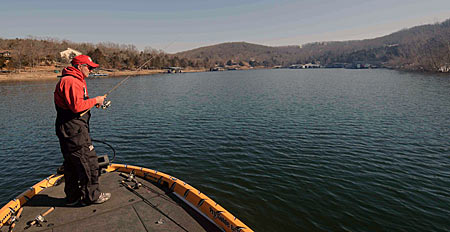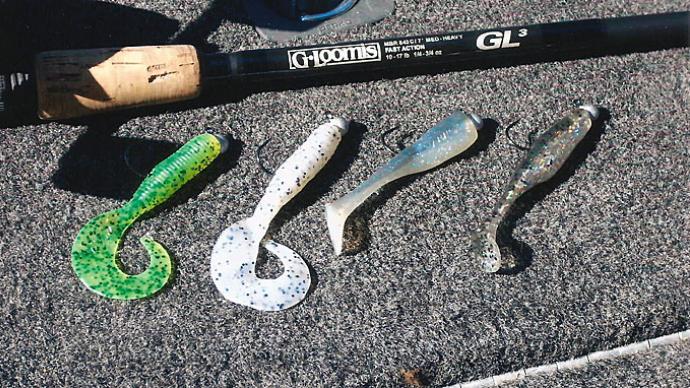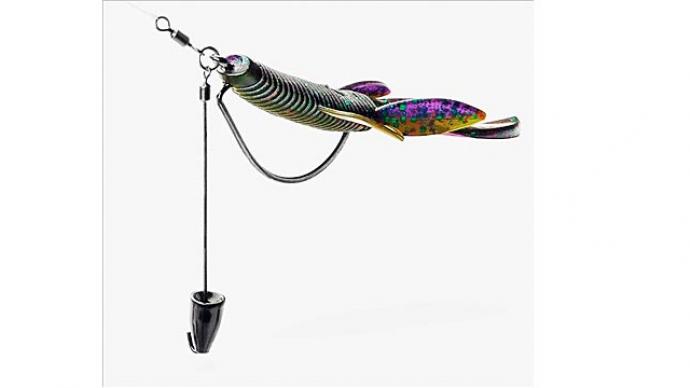
The tantalizing twisting tail of a plastic grub attracts strikes from a wide range of game fish, including all three species of black bass.
Table Rock Lake guide Pete Wenners has relied on the single-tail plastic grub in tournaments or for his clients to catch bass throughout the years. “It is a lure you can fish 12 months of the year,” Wenners says. “It matches the bait size and is a superior bait for suspended bass. Before the drop shot came out, all we vertical fished with were a grub, tube jig, or a spoon.”
The Missouri angler presents the grub horizontally and vertically to suspended bass depending on the depth of the fish. His favorite times to throw a plastic grub are during the prespawn and postspawn when bass are staging on points at the mouths of spawning pockets.
During the March 2017 Bassmaster Central Open on Table Rock, Wenners finished fifth in the event by catching most of his fish, presenting plastic grubs horizontally and vertically to suspended bass. “I was catching some suspended bass casting (in shallower water), and then I would get over a group in water over 20 feet or deeper where I would just drop the grub straight down and vertical fish it,” Wenners says.
The Table Rock guide has used a variety of plastic grubs made by Yamamoto, Bass Pro Shops, Kalin’s, and Chompers in 4- and 5-inch sizes. “Probably my favorite day in and day out is the Chompers,” Wenners says. The size grub Wenners uses varies daily, but he notices the 4-inch model is the most consistent.
Wenners opts for plastic grubs in three primary colors: salt-and-pepper (white), smoke with black flake, and watermelon with black flake. The forage bass are feeding on, and water clarity determines which color grub Wenners selects each day. “If I feel like the fish are feeding heavily on shad, then the smoke or salt and pepper works better,” he says. “The white seems to work better in off-color water, whereas the smoke works better in clear water. If the bites are coming close to the bottom and I am seeing tentacles and crawdads coming out of the fish, that is when the watermelon color seems to work a little better.”

A homemade darter jighead equipped with a 3/0 or 4/0 light wire hook is Wenner’s choice for attaching to a plastic grub. He uses the jighead with a 4/0 hook for targeting heavier largemouth bass and changes to the jighead with the 3/0 hook for catching spotted and smallmouth bass.
The tournament competitor favors rigging his plastic grubs on an open hook without a weedguard. “I lose a few more baits like that, but I feel that I hook more fish on the open hook,” he says.
When rigging his grubs on the jighead, Wenners positions the grub so the eye of the jighead faces upward and the grub’s tail points downward. He believes the grub’s tail displaces more water and generates more action with it pointed down.
Most of the time, Wenners matches his grub with a 1/4-ounce jighead. He switches to a 1/8-ounce model for fishing in shallower water and opts for a 3/8-ounce jighead to get better contact with the lure in windy conditions.
The tackle Wenner’s uses for grub fishing consists of a 7-foot medium action Lew’s spinning rod and Team Lew’s spinning reel filled with 6-pound test line. He opts for fluorocarbon when he needs the sensitivity to feel light bites and switches to monofilament for most of his grub tactics because it is more manageable and kinks up less, especially in cold water.
A Garmin Panoptix unit helps Wenners present his plastic grub to schools of suspended bass. “The awesome thing about the Panoptix is when you get around a school of fish or bait and suddenly lose them, then you can just fan the trolling motor with the Panoptix and locate where the fish are,” he says. “It will also tell you how deep the fish are.”
When he figures out the depth of the bass, Wenners casts beyond the school and counts down his grub, which he estimates falls 1 foot per second with the 1/4-ounce jighead. “The key is that as soon as the bait hits the water, you want to engage your reel and turn it a time or two to get the slack out of your line,” Wenners says. “So as you are counting it down, you can watch that line because a high percentage of your bites will come before it reaches the depth you are counting it down to.”
Two retrieves produce best for Wenners when he casts his grubs. He employs either a slow, steady retrieve keeping his lure at the same depth as the school of bass, or when his lure drops to the depth of the fish, he pumps the grub by lifting his rod from the 10 o’clock position to 12 o’clock position. Then he drops the rod back down to let the lure fall. “A lot of the bites are going to come on the drop as you drop the rod tip, and your bait is going down,” Wenners says.
His plastic grub tactics produce mostly numbers of bass for Wenners, but he has also caught quality fish with the grub. He usually catches his heaviest fish on the grub during the prespawn when female bass are laden with roe.




